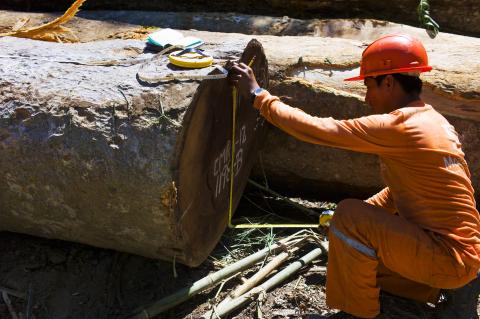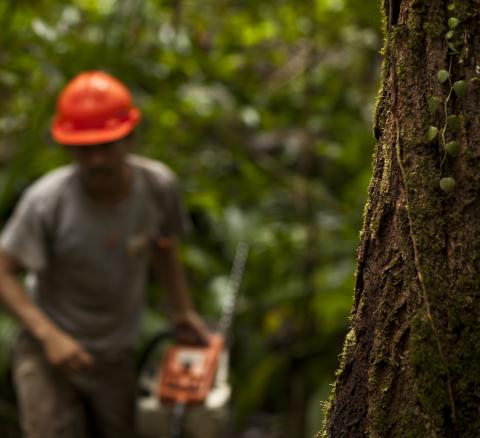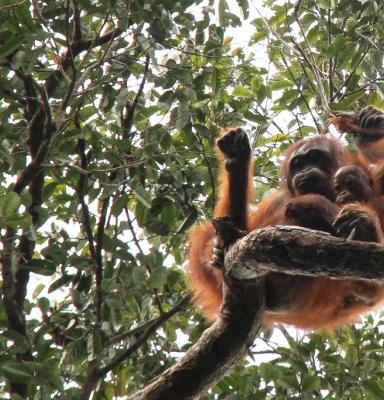
7 Steps
Select the ecosystem services that you want to demonstrate a positive impact for
What ecosystem services do we protect?
Carbon
Water
Soil
Biodiversity
Recreational services
Describe the selected ecosystem service
Current and past condition, beneficiaries, threats etc.
Choose an impact and develop a theory of change
Do we want to maintain, conserve, restore or enhance the ecosystem services? What management activities do we think contribute to this?
Choose the specific impact from Annex B of the Ecosystem Services Procedure and build a so-called Theory of Change: a diagram explaining how your forest management activities are expected to achieve the selected impact.
Determine what you need to measure to demonstrate the selected impact
Which outcomes do we need to measure to indicate maintenance, conservation, restoration or enhancement of the ecosystem services?
Select an outcome indicator, e.g. natural forest cover, lever of disturbance, water turbidity etc.
Determine how you are going to measure the selected impact
How will we measure the ecosystem service indicators? In other words: what methodology are we going to use?
Select a methodology. See suggestions in FSC-GUI-30-006, including the FSC Forest Carbon Monitoring Tool (more information below).
Measure the indicators and make a comparison
Measure and determine what comparison you need to use for your measurement.
Compare with previous values, reference site or credible description of natural condition.
Draw a conclusion based on your measurement and the comparison to see whether you successfully demonstrated a positive impact
Results: did we maintain, conserve, restore or enhance the ecosystem services?
YES? Congratulations, once the certification body verifies your impact, you can use ecosystem services claims.
NO? Go back to Step 3 and reconsider your theory of change, you may need to change your management activities.
Implementation
Successful use of the Ecosystem Services Procedure
The FSC Ecosystem Services Procedure has been successfully implemented in FSC certified forests all over the world. Forest managers adopt various business models to get an added benefit from demonstrating the positive impacts of their forest management practices on ecosystem services.
-
Forestal Arauco S. A. offering recreational services in Chile
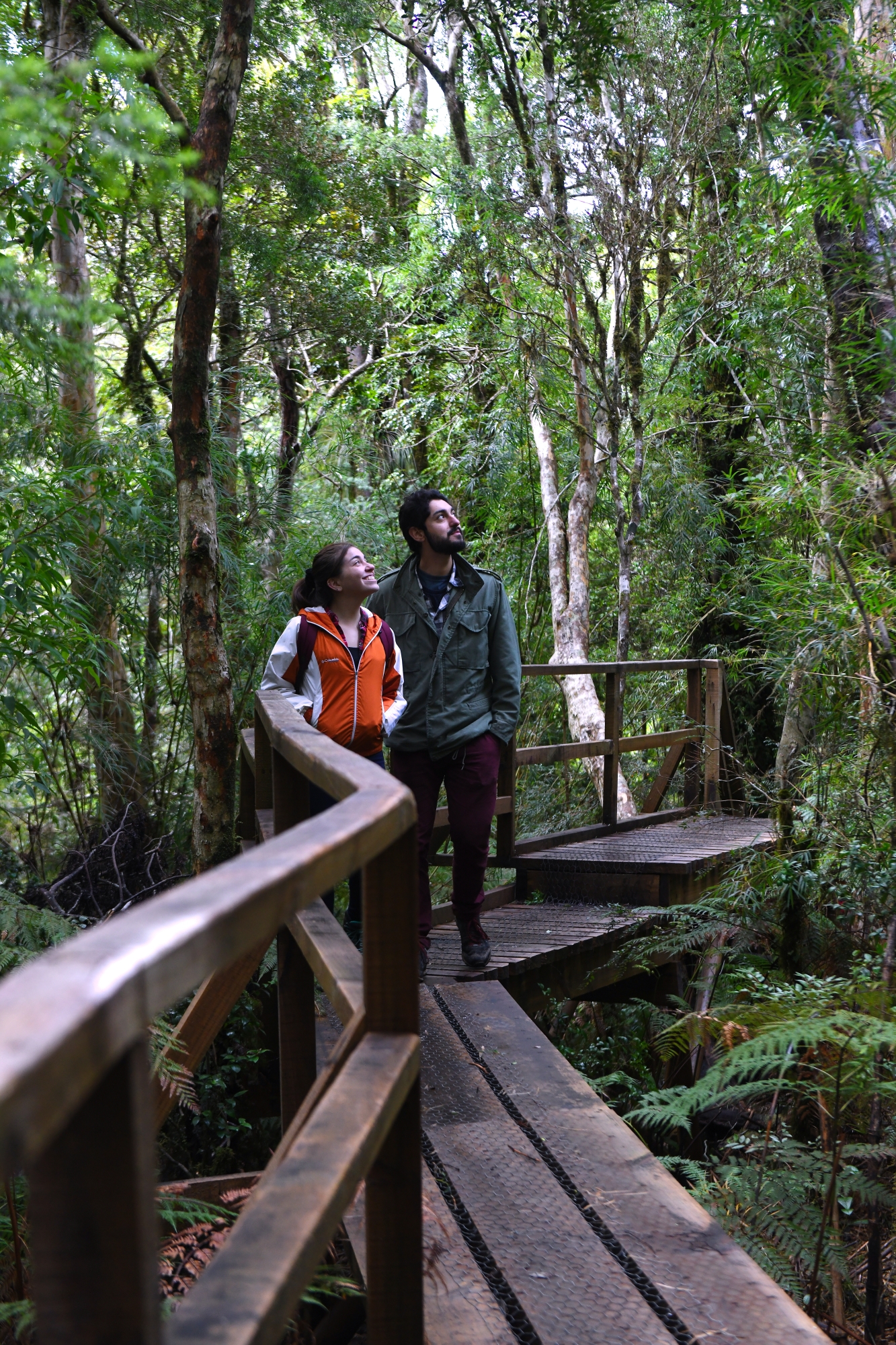
Forest Management:
Large forest plantation company, FSC certified since 2013Ecosystem Services:
Verified positive impacts on recreational servicesBusiness Model:
Improved stakeholder relationships and brand imageForest Impact Story:
Forestal Arauco S.A. is a major forest plantation company in South America. In Chile, it manages over 1 million hectares and is FSC certified since 2013. In line with its corporate social responsibility policy, Arauco set aside 2,481 ha for preservation and recreational purposes in one of the last bits of Selva Valdiviana Costera.
Parque Oncol, as it was called, is an evergreen mixed and highly endemic forest, hosting 90 species of animals and 89 plant species. There are also panoramic views of surrounding beaches, valleys, Andes mountains and volcanoes.
All these factors make it a popular spot for recreation and ecotourism.
Between 2011 and 2018, the surface of the park designated for tourism grew three-fold (from 754 ha to 2,481 ha), and the number of visitors was boosted from around 12 to over 18 thousand. Meanwhile, tourist infractions, accidents and non-permitted activities in the area decreased through the promotion of public awareness activities, and tourism infrastructure was expanded. Sightings of certain key species have also increased, such as the Puma Concolor and the Great Andean Fox. Arauco is further tackling threats such as invasive species and fires.

Using the FSC Ecosystem Services Procedure, Arauco successfully demonstrated the positive impacts of their efforts on: maintenance/conservation of areas of importance for recreation and/or ecotourism (ES5.1) and maintenance/conservation of populations of species of interest for nature-based tourism (ES5.3).
Juan Andrés Anzieta, Head of Environmental Management and Community Engagement at Arauco, sums up the experience in one sentence: “Thanks to FSC’s Ecosystem Service Procedure we now have the tools to measure, verify and communicate about the positive impacts of our management practices to protect this unique forest and its biodiversity, while inviting visitors to enjoy its beauty.”

-
Waldplus GmbH demonstrated positive impacts on all five ecosystem services in Italy

Forest Management:
Group certification,
FSC certified since 2014Ecosystem Services:
Verified positive impacts on carbon sequestration and storage, biodiversity conservation, watershed services, soil conservation, and recreational servicesBusiness Model:
Financial sponsorship by various companiesForest Impact Story:
WaldPlus, a group of 33 members managing over 1,000 ha of forest spanning between the regions of Trentino Alto-Adige, Friuli-Venezia Giulia, Veneto and Lombardy, in Italy, has successfully demonstrated positive impacts on all five ecosystem services: biodiversity, carbon, water, soil and recreational services.
Using a demand-based approach, ETIFOR, a spin-off consultancy from the University of Padua and expert in ecosystem services sales, found investors looking to create a positive impact on forests, the climate and other ecosystem services. For example, the glass-only bottling water company Levico Acque is generating positive climate impacts restoring FSC certified forests that result in the capture and conservation of carbon.

Every citizen and company can today support the growth of new trees and better forest management of the WaldPus forests directly at the website WOWnature.
“We scientifically calculate how useful trees are for our lives and how their services can generate an economic return for forest owners. Thanks to FSC certification we can now guarantee that these benefits are visible and quantifiable” stated Lucio Brotto, Sustainable Investments Director at Etifor.
Elmar Gruber, WaldPlus group manager, added that “This achievement gives the right recognition to forest managers who are committed to responsible management practices.”
See an overview of institutions financially supporting Waldplus here.
-
KMPH Mitra Sesaot demonstrated positive impacts on watershed restoration on Lombok, Indonesia
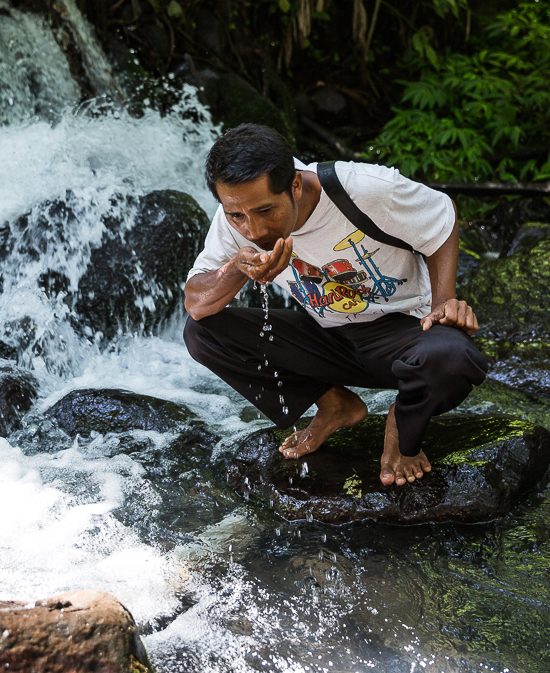
Forest Management:
Community-managed forest,
FSC certified since 2017Ecosystem Services:
Verified positive impacts on watershed services
Business Model:
Payments for ecosystem services by water users
Forest Impact Story:
On the island of Lombok, Indonesia, past forest degradation in the Jangkok watershed has resulted in decreased water availability and resulting droughts / water shortage, which affected the relatively fragile ecosystem of Lombok. Since 2009, reforestation and forest enrichment activities are being carried out to restore the watershed, using multi-purpose tree species.
Local communities as well as the inhabitants of the downstream Mataram city benefit from the forest restoration activities, not only from the fruits collected from planted trees, but also from payments for water provision. In a study by Jaung, Wanggi, et al. (2016), it was found that stakeholders in the area were interested in the certification scheme as a capacity-building tool. Using the FSC Ecosystem Services Procedure, the positive impact on water (ES3.3: Maintenance of the capacity of watersheds to purify and regulate water flow) has been demonstrated for 185 ha of community-managed forest ‘Mitra Sesaot’.
*Jaung, Wanggi, et al. "Certification of forest watershed services: AQ methodology analysis of opportunities and challenges in Lombok, Indonesia." Ecosystem services 22 (2016): 51-59.
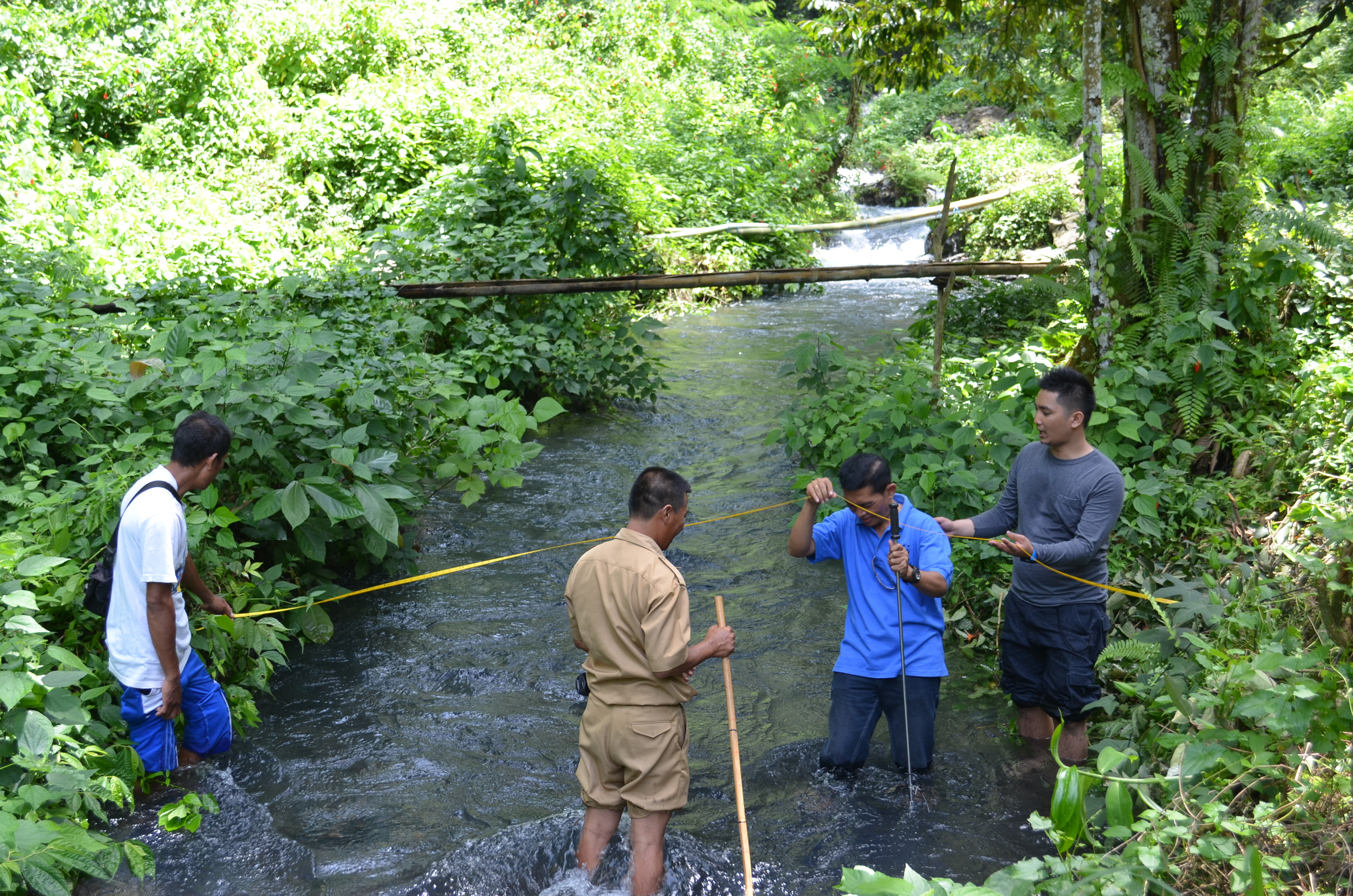
Rahman, KMPH’s chairman, affirms the reforestation efforts have been very effective: “This can be seen from the condition of rivers and spring waters. The water quantity has begun to stabilize, the river flow no longer dries up even in summer, and there is always enough water discharge for the hydropower plant. Water quality is also getting better – it’s being used by the water company, and by forest communities for drinking.”
Mataram city agreed to participate in a payment for ecosystem services (PES) scheme to finance the forest restoration activities. The water company collects funds from households in Mataram city that are then channelled to the communities restoring the forests upstream in the watershed. Total annual agreed payments are 500 million IDR, or ~35,000 USD. After KMPH Mitra Sesaot were able to demonstrate the positive impacts of their restoration work on watershed services, six private companies (hotels) were convinced to join the PES scheme and contribute as corporate beneficiaries of the water services.
The Indonesian government considers that the payment for environmental services in Mataram as a good model and currently several provinces in Indonesia are interested in developing this scheme.
Syachriani, Forest Management Certification Specialist at WWF Indonesia, states that “FSC certification provides assurance that a forest is being well managed, so […] it should have positive impacts for people and nature. If those impacts can be demonstrated and verified, then they are more likely to be recognized by people and rewarded in the market.”
FSC Forest Carbon Monitoring Tool
FSC and the consulting firm UNIQUE developed the FSC Forest Carbon Monitoring Tool and its User’s Manual with input from multiple carbon experts. This instrument helps forest managers calculate the tons of carbon stored in their forest. Forest managers applying the Ecosystem Services Procedure can also use the tool as a complementary method to verify carbon stock conservation and restoration in their properties (see FSC-GUI-30-006, Module 10, page 37).
News
Experimental Plot Adopts the New FSC Forest Carbon Monitoring Tool (September 8, 2020)
Italian Local Entities Join Forces with FSC to Preserve Ecosystem Services (May 19, 2020)
The Miracle of Bamboo (March 18, 2020)
Brazil issues first FSC verified Ecosystem Services impacts on carbon and biodiversity (March 26, 2019)
Training
Attending an ecosystem services training is the best way to learn how the FSC ecosystem services tools add value, how to implement the FSC Ecosystem Services Procedure and how to evaluate ecosystem services impacts. In-person training sessions are offered all over the world. Check the agenda below for upcoming training events.
|
Date* |
Location |
Language |
Organiser |
More info |
|
28 - 29th September 2021 |
Online |
English |
Soil Association |
* Due to the coronavirus, no in-person trainings will take place in the coming months. This section will be updated as soon as the situation will allow it.
In 2018, FSC offered a series of webinars to introduce the ecosystem services procedure to various key user groups. Access the webinar targeted to forest managers here. For the recording of the webinar for certification bodies, follow this link.
FAQs
General FAQs
-
What is the difference between ‘validation of an ecosystem service impact’ and ‘verification of an ecosystem service impact’?
Verification of an ecosystem services impact can only take place when the required result from FSC-PRO-30-006 Ecosystem Services Procedure: Impact Demonstration and Market Tools, Annex B is demonstrated. The only difference between validation and verification is that verification has a comparison value that is leading to ‘result’.
Below is an example of FSC-PRO-30-006 Ecosystem Services Procedure: Impact Demonstration and Market Tools, Annex B, ES 1.1: Restoration of natural forest cover. The first three columns are for both validation and verification. To verify a positive impact on ecosystem services, the fourth column (Comparison: Compare present value to) which indicates what the measure has to be compared to (Clauses 9.2–9.3) and the result of this comparison has to comply with the requirements indicated in the fifth column (Required result) (Clause 10.1).
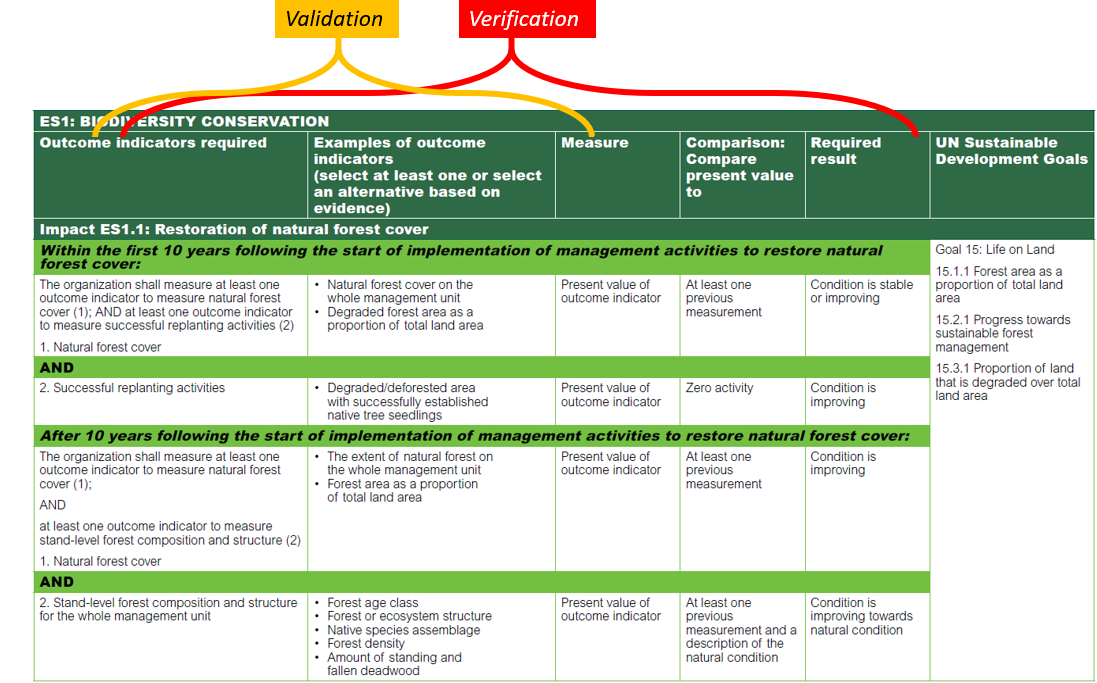
-
How much time should be calculated for the verification of an ecosystem services impact?
ADVICE-20-007-19 (FSC-DIR-20-007) provides advice to certification bodies on forest management auditing time. When the evaluation of ecosystem services is included in the scope of the assessment, this will increase audit time. The time required to verify ecosystem services impacts depends on a number of factors, including:
- whether the verification of ecosystem services impacts is integrated in the forest management audit or scheduled separately;
- the number of ecosystem services impacts to be verified;
- the type of impact(s) to be verified and the chosen methodologies to measure the outcome indicator(s);
- whether it is the first ecosystem service impact evaluation or a subsequent evaluation;
- the specific context of the forest management organisation.
To minimize costs for the forest manager and maximize efficiency for the certification body, ecosystem services impacts should be evaluated during forest management certification audits (clause 17.4 of FSC-PRO-30-006).
Generally, the more ecosystem services impacts are to be verified, the more time will be required for the evaluation.
Experiences from pilot testing and field testing of draft versions of the FSC Ecosystem Services Procedure revealed that about 1-3 auditor (person) days are needed in addition to the forest management assessment.
Ecosystem services impacts shall be verified at least every 5 years or at each main forest management evaluation (clause 17.1 of FSC-PRO-30-006). There is no need to include ecosystem services verification in surveillance audits, unless:
- there is a need to evaluate the closure of non-conformities identified in previous evaluations;
- there are significant changes in the ESCD (see FAQ 3).
-
Who decides what a significant change in the ESCD is? And what is the process for determining whether or not to conduct a surveillance audit or a scope extension audit for ecosystem services?
Significant changes in the ESCD include:
- the addition of a new impact;
- significant changes to the theory of change (for example: a change in management practices);
- changes to the selected outcome indicators;
- changes to the methodologies used to measure the outcome indicator;
Other reasons for conducting a surveillance audit include a change of scope in the management unit(s) for which the impact is demonstrated, and monitoring results that would question the verified ecosystem services impact.
During the forest management audit preparation phase, the certification body should ask the certificate holder whether there are any changes to the ESCD and/or whether there could be any other reasons to conduct a surveillance audit. By latest 30 days prior to the scheduled forest management evaluation, the certificate holder should inform the certification body on the nature of any changes to the ESCD.
-
How is an ecosystem services claim approved?
For any verified ecosystem services impact, an ecosystem services claim can be used.
A separate approval is required when an FM, FM/COC or COC certificate holder or Promotional Licence holder uses FSC trademarks to promote ecosystem services claims (see FAQ 5).
Certification bodies will also need to verify the passage of ecosystem services claims along the supply chain through sales and/or delivery documents.
-
How does FSC trademark use approval work for ecosystem services claims?
There are different potential uses and users of the FSC trademarks in association with ecosystem services claims as explained in Part IV of the FSC-PRO-30-006 Ecosystem Services Procedure: Impact Demonstration and Market Tools.
Forest managers that have an ecosystem services claim for the forest under their management may want to promote this via a news item or a video on their website or via other communication channels.
FSC chain of custody (CoC) certificate holders may want to promote forest products that carry an FSC Ecosystem Services Claim. CoC certificate holders and non-certificate holders alike may be involved as a financial sponsor of ecosystem services and as such may want to communicate about their support for the maintenance/conservation or restoration/enhancement of the ecosystem service.
Whether certificate holder or not, retailers and other organisations may also want to promote FSC 100% products that carry an FSC Ecosystem Services Claim.
Buyers and sellers of external assets (e.g. carbon credits) that carry an ecosystem services claim or the registries listing such assets may also want to promote these assets with an FSC ecosystem services claim. These buyers may be CoC certificate holders or non-certificate holders.
The users of the FSC trademarks in association with ecosystem services claims will propose the content for the promotion of ecosystem services claims.
The approval for the use of FSC trademarks in association with ecosystem services claims is done by:
- Forest management accredited certification bodies for forest management certificate holders
- Chain of custody accredited certification bodies for CoC certificate holders
- FSC trademark service providers for non-certificate holders (use of the FSC trademark requires a promotional licence)
Part IV of the FSC-PRO-30-006 as well as section 7 and Annex 1 of the FSC Trademark Use Guide for Promotional Licence Holders provides examples of wording that can be used to promote ecosystem services claims. It is important that any embellishments of ecosystem services claims (for example when story-telling is used) are based on facts included in the publicly available ecosystem services certification document (ESCD).
FSC trademark use by FSC certificate holders shall be in compliance with FSC-STD-50-001.
-
Can new members of forest management group certification also make ecosystem services claims for ecosystem services impacts that have been verified for that group?
Ecosystem services evaluations follow the existing normative requirement around group certification for forest management certification.
FSC-STD-30-005, clause 3.4 states that “The Group entity or the certification body shall evaluate every applicant for membership of
the Group and ensure that there are no major nonconformities with applicable requirements of the Forest Stewardship Standard, and
with any additional requirements for membership of the Group, prior to being granted membership of the Group.”FSC-STD-20-007, clause 6.3.5 states that “The number of FMUs to be visited in a surveillance evaluation of forest management groups shall be determined according to Annex 1. If new FMUs (e.g. group members or newly acquired FMUs) have been added to the scope of the certificate since the main evaluation, the new FMUs shall be sampled at the rate of a main evaluation”.
This means that group managers can add new members to the group without the immediate need of a certification body to evaluate compliance, as long as the certification body is confident that the procedures and internal control systems provide sufficient safeguards for a credible expansion of the group.
Certification bodies can use the same sampling approach to select group member for the evaluation of ecosystem services, in line with Annex 1 of FSC-STD-20-001. When ecosystem services is part of the scope of an evaluation, this should be an additional factor to weigh in on the decision what members and sites to include and to visit during the evaluation.
-
In case of group certification, does each group member (forest) need to have a separate ecosystem services certification document (ESCD)?
It should be one ESCD per ecosystem service for a Certification Holder (CH) (see clause 1.5.2 FSC-PRO-30-006) where a CH could include multiple Management Units (MUs), e.g. in case of group certification.
This means that if all group members pursue positive impacts on the same ecosystem services (e.g. all members want to demonstrate positive impact of their management activities on watershed services), are under the same management and the same methodology is used to measure certain outcome indicators, then one ESCD per ecosystem service is sufficient. If, however, every member is pursuing to demonstrate a positive impact on a different ecosystem services (one member wants to demonstrate positive impacts on carbon, another on biodiversity, a third on recreational services), then there will be separate ESCDs.In practice, it may be easier i.e. clearer to develop one ESCD per impact (even if multiple impacts within an ESCD are possible, e.g.
multiple biodiversity impacts demonstrated for a CH).(Refer to: FSC-PRO-30-006, Ecosystem Services Procedure: Impact Demonstration and Market Tools, clause 1.4 and 1.5.2)
-
Can an ecosystem services impact be demonstrated for a part of the management unit or does it need to be done for the entire management unit?
Some of the ecosystem services impacts can be validated/verified for a part of the management unit, whereas for others the impact needs to be demonstrated for the entire management unit. Annex B of the FSC Ecosystem Services Procedure stipulates per claim what is needed in terms of scope and monitoring). Please see the required outcome indicator(s) and the required result (Refer to: FSC-PRO-30-006 Ecosystem Services Procedure: Impact Demonstration and Market Tools, Annex B) and when there is a statement ‘on management unit’, the scope is the entire management unit. For example for ES2: Carbon sequestration and storage (see figure).

-
If there is an event outside of the Organization’s control that damages the declared ecosystem service, shall/should the ecosystem services certification document ESCD be updated before the 5-year cycle?
And shall/should the ecosystem services claim and any promotional statements/communication be also updated/changed?
Events outside of the Organization’s control are part of the contextual factors that may influence whether or not the outcome and impact is achieved (see box 1 and clause 6.5 of FSC-PRO-30-006 Ecosystem Services Procedure: Impact Demonstration and Market Tools).
In case a natural disturbance, for example forest fire, negatively influences the ecosystem services to the extent that one can no longer proof there is conservation or maintenance of that ecosystem service, the Organization loses the ecosystem services claim including the rights to use the FSC trademarks to promote that conservation/maintenance claim. However, the Organization can restore the damage done by the external event and pursue a restoration impact on that same ecosystem service. This entails a revision of the ESCD, including the Theory of Change, and the Organization may start with a validation of the restoration impact. As soon as the restoration impact is verified, the Organization will be able to use the FSC trademark in communicating about restored ecosystem service. -
How long is the ecosystem services claim valid?
The validation goes until the next ecosystem service evaluation, so it would be maximum in 5 years.
FAQs for Certification Bodies
-
Do Certification Bodies need a separate accreditation for ecosystem services, and do they need to pass a witness audit before being able to evaluate ecosystem services impacts?
No. The scope section of the FSC-PRO-30-006 Ecosystem Services Procedure: Impact Demonstration and Market Tools (p.6) states that: “Evaluating compliance with this procedure is within the scope of FSC forest management accreditation. An audit by Accreditation Services International (ASI) is not required before the certification body evaluates compliance with this procedure; ASI will carry out surveillance of the certification body’s compliance with Part V of this procedure through regular desk and witness audits.” The same applies for chain of custody-accredited certification bodies approving FSC trademark use in accordance with Part IV of the procedure.
However, at least one member on the forest management audit team shall be trained on the ecosystem service(s) under evaluation or have proven competence based on past experience (Clause 20.1 of FSC-PRO-30-006, p.29), see FAQ 12 below.
-
What kind of training or competence on ecosystem services would be considered sufficient for the member of the audit team under Clause 20.1?
In clause 20.1, training and competence refers to education and/or professional experience that the member of the audit team has acquired through, for example, education at university, courses and/or on-the-job training and experience on one or more ecosystem services.
Annex 3 (audit teams) of FSC-STD-20-001 is relevant in this regard, particularly box 2 on key considerations for selection of audit team members for forest management audits. Under the heading ‘Environmental issues’, “other environmental issues that are likely to be of importance during the audit” includes the declared ecosystem service(s).
The member on the audit team needs to be able to assess the choice and use of the methodology and interpret the results for the ecosystem service(s) under evaluation. This means that he or she may need to have a background or knowledge in, for example, ecology, forestry, biology, natural resources management, hydrology, soil management, or ecotourism.
The certification body shall ensure that the team member is competent in the ecosystem services subject matter that is being evaluated. Ways in which such competence can be demonstrated include: university diploma, course certificate, technical outputs (e.g. report, presentation, data analysis) of a project in which the team member had a leading role on the technical aspects and/or publication in a peer-reviewed journal.
-
A certificate may be 3 years into the 5 year validity period at the point that the ecosystem services impact is verified.
In such case, do we include the ecosystem services impact with an expiry or validity only for the remaining 2 years of the forest management certificate or can we issue the ecosystem services impact with a validity which goes beyond the end of the forest management certificate – subject to successful reevaluation?
You can use the ecosystem services impact with a validity that is longer than the forest management certificate. It needs to be ensured, however, that it expires as soon as the forest management certificate is not renewed/terminated for some reason.
(Refer to: FSC-PRO-30-006 Ecosystem Services Procedure: Impact Demonstration and Market Tools, Clause 17.1) -
What information will be needed for the FSC database in relation to ecosystem services?
The ecosystem services certification document (ESCD) needs to be uploaded in the FSC database and – in case there are any sponsors – also the list of sponsorships (Refer to: FSC-PRO-30-006 Ecosystem Services Procedure: Impact Demonstration and Market Tools, Annex D).
The certification body needs to publish the ESCD only when an impact has been verified. It is important that the ESCD is uploaded as a separate document and under the correct category (Ecosystem Services Certification Document (available on website)), so that it is searchable in the FSC online database info.fsc.org.
In case of successful validation/verification of an impact, the evaluation of the ecosystem services impact(s) also needs to be part of the publicly available forest management report, for example as an annex.
-
Does the ecosystem services certification document (ESCD) belong to the certificate holder or the certification body (CB)? When CB needs to upload it, can CB change wording/ details of ESCD?
The ESCD belongs to the Certificate Holder (CH). Based on the ESCD and information evaluated during the audit (interviews, field
visit) the Certification Body makes a decision on the verification/validation of an ecosystem services impact and in case of a positive decision, the CB fills out the first page of the ESCD with this information. Prior to uploading the ESCD, the CB may request the CH to make certain adaptations to improve clarity or overall quality. -
Is it necessary to include ecosystem services in the public consultation made by the certification bodies?
Yes. FSC-PRO-30-006 Ecosystem Services Procedure: Impact Demonstration and Market Tools, Clause 17 is referencing FSCSTD-20-007, which requires a public consultation by the certification bodies.
-
What happens if there are negative stakeholder comments in relation to an ecosystem services during a forest management audit?
It works the same as with the stakeholder comments during the forest management audits and how these are handled, but then this information can be considered in the evaluation of the ecosystem services impact. During the audit, the team would further investigate the issue(s) brought up and decide on how this information is to be used/weighted in the overall assessment. (Refer to: FSC-PRO-30-006 Ecosystem Services Procedure: Impact Demonstration and Market Tools, Clause 5.1.6: A summary of culturally appropriate engagement with Indigenous Peoples and local communities related to the declared ecosystem service, including ecosystem services access and use, and benefit sharing, consistent with Principle 3 and Principle 4 of FSC-STD-01-001 FSC Principles and Criteria for Forest Management.)
Regarding stakeholder consultation by the certification body on ecosystem services, there are no differences from the normal procedures and requirements as applicable for forest management evaluations (including clauses 1.2c) and 4.3b) FSCSTD-20-007).
-
Can ecosystem services validation be done remotely?
It is not so much the difference between validation and verification that determines whether it can be a desk audit or not. Please refer to: Interpretations of the normative framework Ecosystem Services, INT-PRO-30-006_03 to see under which circumstances desk-based audits are possible.
-
What is the purpose of the ‘results of the evaluation’ section on the front page of the ecosystem services certification document (ESCD)?
Does this mean that the certification body does not undertake a technical review of the auditors’ report before the impact is verified?
The purpose of this front page is to show that the impact has been successfully verified (once this becomes publicly available in the FSC database – info.fsc.org). Ecosystem services verification or validation needs to follow the internal review process within the Certification Body and so the ESCD front page can be filled out once the certification decision has been made.
-
What dates are expected to be used on the first page of the ecosystem services certification document (ESCD) that has to be filled by the lead auditor, ‘results of the evaluation’?
The ‘Approved on’ date is the certification date (as the auditor would do for forest management assessment), and the ‘Valid until’ date is 5 years later.
-
Would an electric signature of the program manager on our certification decisions after report review be OK?
It is fine to use the electronic signature of the program manager.
Ecosystem Services Interpretations
This document contains the interpretations of the FSC normative framework for Ecosystem Services.
